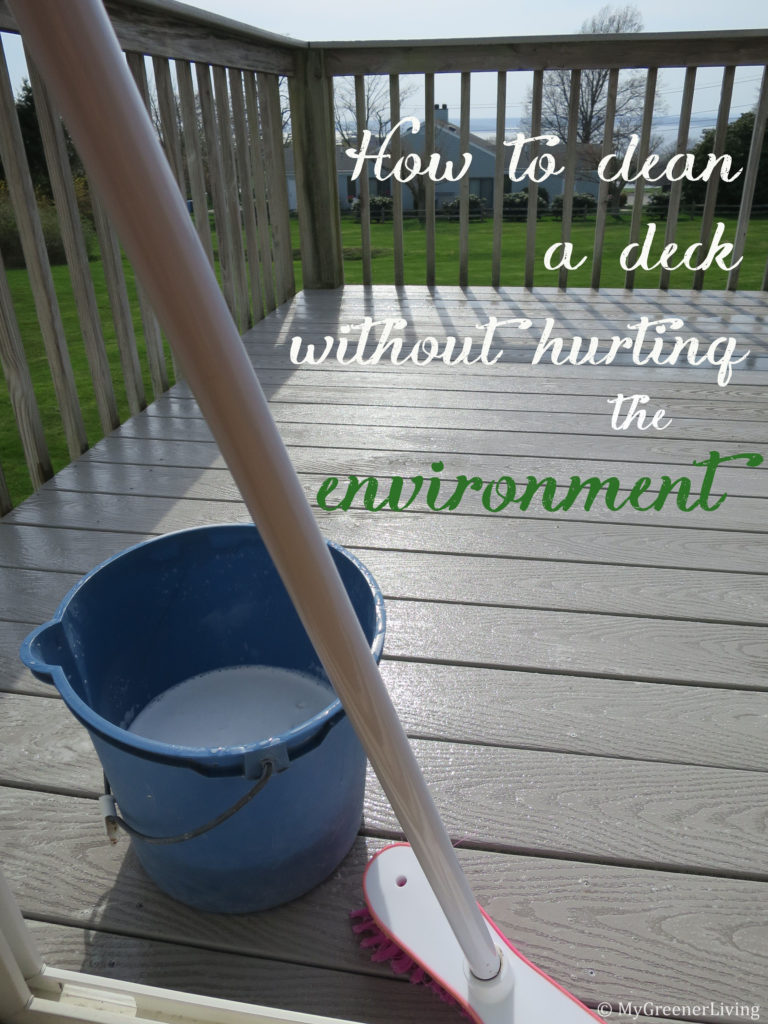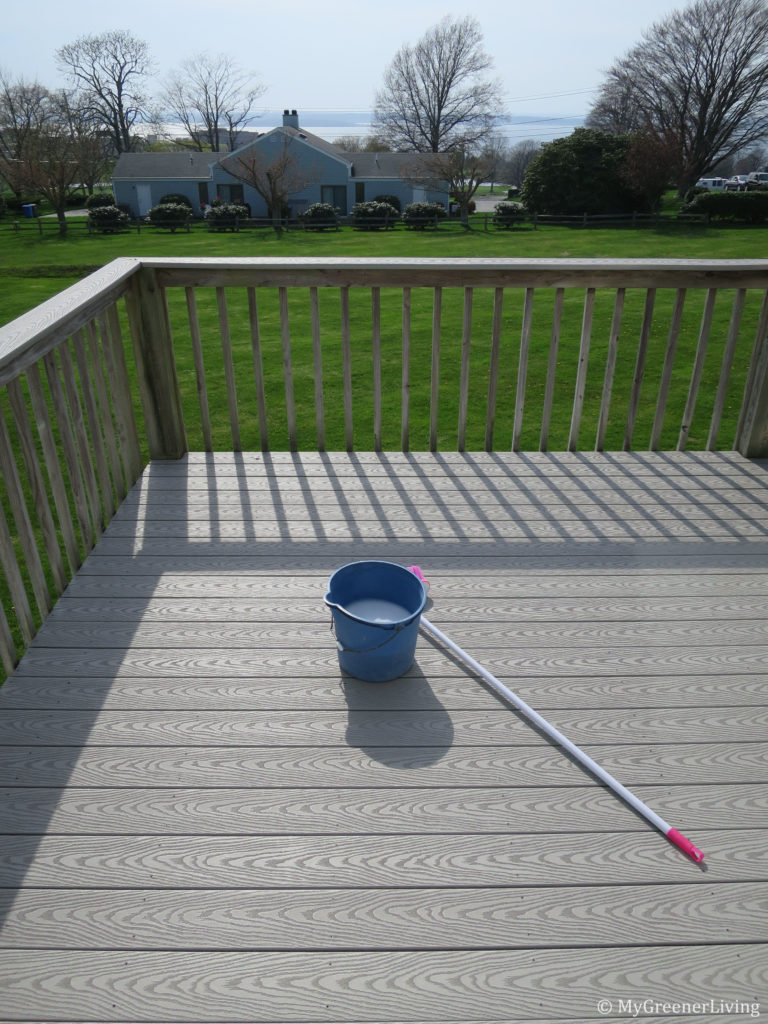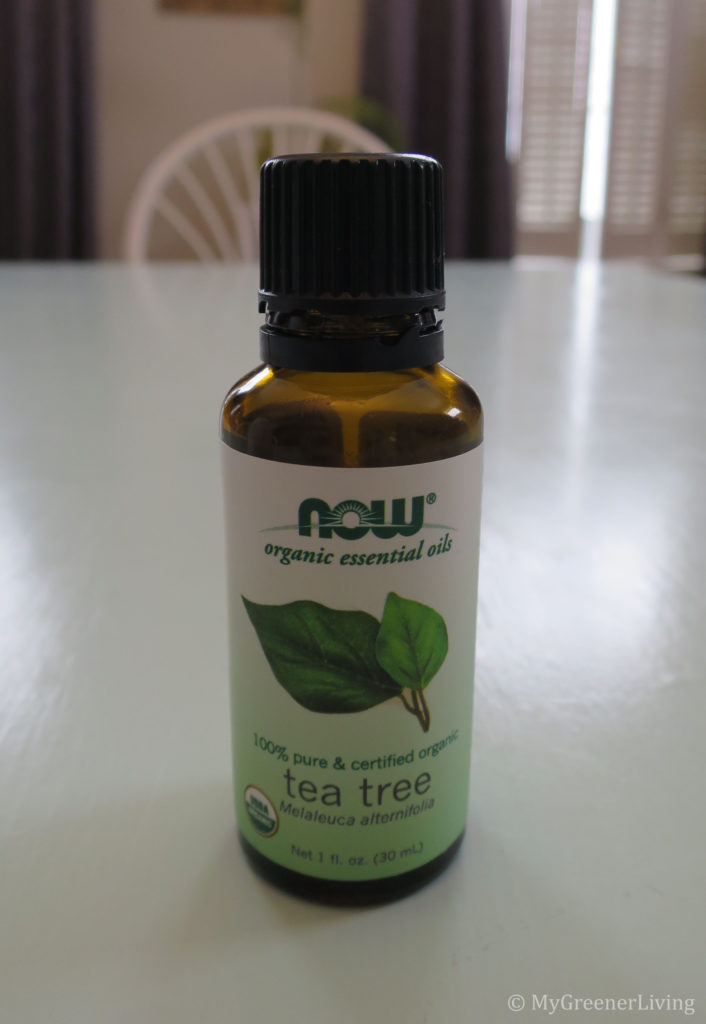We’ve finally had several warm days and I am starting to really look forward to summer. Among many other things, I am looking forward to the warm weather, late sunsets, and relaxing out on my deck enjoying both! Keeping a deck looking nice is really not too difficult, if you’re willing to put in a little effort each year. As with a car, regular maintenance will cut down time and expense in the long run. I am here today to share how easy it is to maintain your deck, and it can be done with environmentally friendly products, too!

Disclaimer: This post contains affiliate links. See my Disclosure Policy for more information.
Most recipes I have found for washing a deck include harsh detergents and chlorine bleach, which are not good for people or the environment. Luckily, there are natural alternatives that work great, too! Oxygen bleach (like oxiclean – remember that awesome stuff from my towel washing post?) and liquid castile soap (like Dr. Bronner’s or my homemade soap) plus water and a brush are all you need!
But first – before washing, and whenever you notice an accumulation, brush leaves and other debris off the deck regularly. This organic matter makes a great place for mold and bacteria to grow, so keeping the deck clear is step 1 in keeping the deck clean!
Recipe
This is plenty for a small, well maintained (or new) deck (150-200 square feet). Depending on how large the deck is, and how dried out the decking is, you will need more or less.
Time: I estimate it will take about 10-20 minutes to mix up the recipe then clean off the tools when finished washing, then about 10 minutes per 100 square feet to wash the deck.

- 1 gallon water (I used water from my rain barrel!)
- 1/2 cup sodium percarbonate (active ingredient in OxiClean) or 1 cup OxiClean Baby powder – this is the oxygen bleach
- 1 tablespoon liquid castile soap
- bucket – I used a 2 gallon bucket to mix up the 1 gallon of solution
- brush
- Safety first – I recommend putting on gloves and safety glasses to protect eyes and skin from splashes, and wearing long pants/shoes to protect feet and legs from splashes.
- I pour the oxiclean or sodium percarbonate in the bucket, add water, stir, then add castile soap and stir again.

Instructions
Cleaning composite decks
As of about a year ago, I am the proud owner of a composite surfaced deck. I am proud because I made it composite – I ripped out old, rotten wood boards and installed the composite deck boards myself. Doing the job myself was a great way to save money, but I understand it’s certainly not for everyone! Don’t worry, I won’t judge if you’re thinking “this girl is crazy, I’m hiring a professional to do that job!” I digress…back to cleaning the deck!
I want to keep my deck looking clean and new for many, many years – most composite deck boards have a 15-30 year warranty, so these decks should last a while! My deck is small, 100 square feet, so I created this recipe small. It is and easy to scale up if you have a bigger deck.

How to apply
- Once I mixed up my solution, I dipped my brush in the bucket of water and liberally applied solution to the deck boards. I brushed along the length of the boards, and scrubbed anywhere that I saw stains (a.k.a. bird poo).
- After the solution had been applied to the entire deck, I let it sit for 1 hour (15 minutes should be enough for the oxygen bleach to do its job).
- I rinsed out my bucket and rinsed off the brush.
- a. After allowing the oxygen beach time to work, I rinsed off the solution. The easiest way to do this is with a hose. Rinse thoroughly, and you’re done!
b. But I did not have a hose long enough to reach my 2nd floor level deck, so I filled my bucket with clean water and used the brush to slosh water all over the deck boards (applied in the same manner as application of the solution in step 1). I did this a few times, until there were no more bubbles (from the cleaning solution) when I applied the water with the brush. And I was done!

Hands-on time for washing my 100 square foot composite deck was about 40 minutes, but should be more like 25-30 minutes if you have a hose for rinsing: 5 minutes to gather supplies and mix the solution, 10 minutes to apply, 5 minutes to clean off the tools, and 20 minutes to rinse off the deck (would be more like 5 with a hose). This was super quick and easy! I love that it will only take me 30 minutes or so each year to keep my deck in good condition. I will wipe down railings or hose off the deck periodically before I use it (especially when there’s a lot of pollen around), but this is minimal effort in my opinion.
Cleaning wood decks
I own a deck that has wood structure and composite deck boards, so my experience using this cleaner is with composite decking only. However, based on my research of deck cleaning, the solutions are the same for any material, so this should work on wood as well!
Wood decks can be maintained for many years with annual thorough washing, and re-staining every few years.
Here’s how I would wash my wooden deck, if I had one:
- Once I mixed up my solution, I would dip my brush in the bucket of water and liberally apply solution to the deck boards. I would brush along the length of the boards. If the solution seemed to soak into the boards, I would liberally apply more cleaning solution so the top of the boards appeared wet.
- After the solution had been applied to the entire deck, I would let it sit for 15 minutes to 1 hour – to allow the oxygen bleach (oxiclean) time to do its job.
- If stains remained, I would gently scrub the stains with a bit of the cleaning solution.
- I’d rinse off my scrub brush and bucket.
- Finally, I would hose off the whole deck to remove the cleaning solution.
If I was staining the deck this year, I would allow a couple of dry, sunny days for the deck to dry out, then apply the stain according to the manufacturer’s instructions.

Cost
Oxygen bleach (sodium percarbonate)- ($13.50/5lb)x(1 lb/16 oz)x(8.4 oz/1 cup)x(1/2 cup)=$0.71
Castile soap – Dr. Bronner’s: ($16/32oz)x(1 oz/2 tbsp)x(1 tbsp)=$0.25
Castile soap – my recipe: ($12/128oz)x(1 oz/2 tbsp)x(1 tbsp)=$0.05
water – Used rain water, so free!
Total: $0.71+$0.25=$0.96 using Dr. Bronner’s, or $0.71+$0.05=$0.76 using my castile soap.
It cost me $0.76 to clean 100 square feet of deck, this mixture volume would have been enough for a deck twice the size. So I think I could wash my 100 sq ft deck for more like $0.76/2=$0.38. And there was no environmental impact! Within 6 hours, the sodium perchlorate has broken down to oxygen, water, and sodium carbonate (soda ash), and castile soap (especially when diluted) is very safe.
How do you maintain your deck? Please share your tips and experiences in the comments below!





